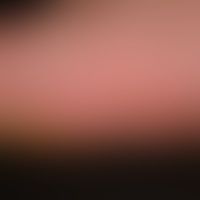Image diagnoses for "Sole of Foot", "Bubble/Blister", "red"
5 results with 9 images
Results forSole of FootBubble/Blisterred

Acrodermatitis continua suppurativa L40.2
Acrodermatitis continua suppurativa. moderate infestation of the feet. grouped blisters and isolated pustules (Note: in case of so-called dyshidrotic clinical pictures on hands and feet with regular and intermittent pustules, the diagnosis "dyshidrotic eczema" is unlikely. inflammatory plaques aggregated on individual toes.

Hand-foot syndrome T88.7
Hand-foot syndrome: acute, drug-induced, painful erythema in the palmar and plantar area; typical drug history for anthracyclines (doxorubicin).

Hand-foot syndrome T88.7
Hand-foot syndrome: after chemotherapy. grade 3: extensive blistering; oozing, coarse lamellar desquamation; ulcerations, severe pain. considerable discomfort that makes everyday business impossible.

Hand-foot-mouth disease B08.4
Hand-foot-mouth disease: numerous, acute, painful, polygonal vesicles with a red courtyard; unspecific flu-like prodromas lasting about 2 weeks before.

Dyshidrotic dermatitis L30.8
Eczema, dyshidrotic: chronically recurrent, slightly infiltrated plaques on the right foot of a 43-year-old man. Furthermore, reddish-brown, partly encrusted, punctiform, older erosions appear in places where water clear vesicles were previously present. Occasionally pinhead-sized, bulging water clear vesicles as well as fine-lamellar scaly deposits. Similar skin lesions are also present on both plantae and the edges of the toes.

Hand-foot syndrome T88.7
Hand-foot syndrome: after combined chemotherapy. grade 3: extensive blistering; oozing, coarse lamellar desquamation; ulcerations, severe pain; considerable discomfort that makes everyday business impossible.

Hand-foot-mouth disease B08.4
hand-foot-mouth disease: fresh and older painful blisters (and pustules) with a red courtyard that have appeared in several attackssince 1 week; individual apthous lesions on the palate and the lip mucosa; unspecific flu-like prodromas that have persisted for about 2 weeks before.

